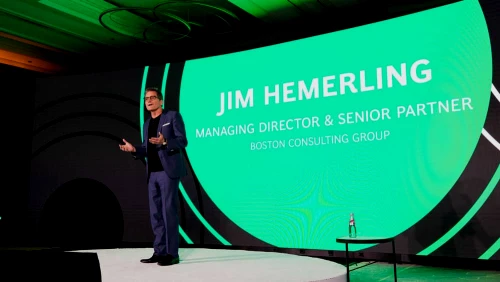Generative leaders leave the world a better place than they found it.
Today more than ever, we are relying on our leaders to deliver. We’re asking more of them than we have in decades.
Put yourself in the shoes of a business leader—or, if you happen to be one, keep those shoes on. Here are some of the daunting priorities and concerns likely to occupy your mind every day:
| • Short-term results | • Climate and environmental footprint |
| • The great resignation | • Employee safety and mental health |
| • Speaking out on societal issues | • Employees’ demands for more flexibility |
| • Artificial intelligence | • Shrinking competitive advantage |
| • Geopolitical risk | • Ecosystem collaboration |
| • Customer journeys | • Always-on transformation |
Each of these issues is complex and high stakes. And as if that weren’t enough, when not on the job, leaders are also worrying about the COVID-19 pandemic's impact on their own families.
But here is some good news. We ran a year-long research project to examine how business leaders are currently performing and what people want and expect from them. Notably, 75% of the 9,000 employees who responded to our survey said they were satisfied with how leaders performed during the first wave of the pandemic.
Generative Leadership
Our research suggests that what worked during the pandemic can form the basis for an approach to leading that we call generative.
Generative leaders strive to leave the world a better place than they found it. With so much at stake, they are seizing a rare opportunity to do better not just for their shareholders, but for their customers, for their teams, for society, and for the planet as well. Shareholders are of course vital stakeholders, because as one client told us, “You don’t get to have a long term without a short term.” But shareholders sit alongside a set of other stakeholders whom generative leaders view as vital to the future. Generative leaders believe that their obligation to society and the planet is at the core of their businesses, not just an afterthought. (For an example, see the sidebar, "Generative Leadership Up Close at Microsoft.")
Generative Leadership Up Close at Microsoft
“The company was sick,” Nadella wrote in his 2017 book, Hit Refresh. “Employees were tired. They were frustrated. They were fed up with losing and falling behind despite their grand plans and great ideas.”
Nadella and his leadership team embraced a generative approach to leadership that has led to a remarkable transformation. Guided initially by a new “mobile first, cloud first” vision, Nadella and his team shifted investments away from Windows toward Azure, Microsoft’s cloud offering. The company also made bold bets on the future, such as investments in AI. As stated in its 2017 annual report, “Our strategy is to build best-in-class platforms and productivity services for an intelligent cloud and an intelligent edge infused with artificial intelligence.”
These big changes in direction and priorities required a more engaged, empowered, and inspired team. Nadella moved to transform Microsoft’s adversarial, competitive culture into one focused on a growth mindset, collaboration, an obsession with the customer, and diversity and inclusion—while also making a difference to society. Instead of a company of “know-it-alls,” as Nadella put it, Microsoft endeavored to fill itself with “learn-it-alls”—and to transform its leadership team to reflect this learn-it-all culture, as well.
Microsoft became more dynamic and entrepreneurial, breaking down stifling product and leadership silos, modernizing engineering practices, and turbocharging its go-to-market capability. The company abandoned its harsh rivalries with competitors and forged partnerships with Apple, Google, and Salesforce, contributing to a collaborative ecosystem. As Nadella said, “It is incumbent upon us, especially those of us who are platform vendors, to partner broadly to solve real pain points our customers have.”
The company’s financial results have been extraordinary. Since 2014, Microsoft’s market capitalization increased seven-fold, from around $300 billion to more than $2.1 trillion in early March of 2021.
Microsoft generated this wealth for shareholders at the same time that it was pursuing social goals. Its mission “to empower every person and every organization on the planet to achieve more” has encouraged the company to address big problems like climate change. In 2020, Microsoft cut its carbon emissions by 587,000 metric tons, purchased the removal of 1.3 million metric tons of carbon, and committed to match 100% of its electricity consumption with zero-carbon energy purchases by 2030.
Microsoft is also partnering with governments to solve a variety of social challenges by leveraging the company’s financial resources, technologies, and AI capabilities. It has undertaken initiatives to make broadband affordable, established a $1 billion Climate Innovation Fund, and developed a Planetary Computer to help manage and protect Earth’s natural systems. “The most useful thing I have done is to anchor us on the sense of purpose and mission and identity,” Nadella said. “There is a reason we exist.”
Many leaders labor under the false impression that there must be a tradeoff between doing good for society and the planet and delivering returns to shareholders. But studies consistently show a strong positive correlation between companies' commitment to environmental, societal, and governance (ESG) concerns and financial performance. And this outperformance grows over time—by as much as 40%, according to one study. Research also suggests that the best talent, especially among younger workers, increasingly chooses employers with social and environmental policies that match their own personal values.
Take Ikea’s leadership team, for example. Ikea has a long history of steady and profitable business, but its leaders have never rested on past successes. In 2011, when they decided to fundamentally change their company’s relationship with the environment and society, they took immediate and concrete measures. The company started to carefully measure and report on its carbon emissions and those of its thousands of suppliers, and it rolled out stringent ethical and sustainable sourcing policies. Once Ikea’s leaders had a better view of the company's entire supply chain, they set goals to keep improving over time. They linked those goals to their own annual bonuses and made sustainability a critical criterion in every new business case. And, importantly, they made all these changes while continuing to deliver steady returns to their shareholders. (For another example, see the sidebar, "L'Occitane Group's Triple Bottom Line.")
L’Occitane Group’s Triple Bottom Line
“One of our key societal challenges is how to move from consuming to regenerating,” Geiger told us. “And the solution lies in nature itself. Nature gives so many examples of how to solve this tension between consuming and regenerating at the same time. The key is to create a sense of purpose for people, and at the same time to provide them with the means to be autonomous in action and find solutions on their own. A strong purpose enables projections and dreams. People need to see in it something positive for themselves and for society.”
In the last several years, L’Occitane has adopted more environmentally sustainable practices, such as more responsible sourcing and recycling and “eco-refill” programs for its products. “My dream is to throw my shower gel bottle into the sea and make it consumable by fishes,” Geiger said. “We’re trying to climb Everest in flip-flops. I don't know if we'll make it in my lifetime. But that doesn’t mean we should stay and enjoy the weather in Kathmandu.”
Geiger said that the focus on GDP has distracted companies from other critical yardsticks. GDP “cannot be the only measure of our reality,” he said. There “is a disconnect between the story we tell ourselves and reality.”
The generative approach comprises three interconnected elements. First, generative leaders look to reimagine and reinvent their businesses. They think expansively about the future they want to create and focus on the right strategic priorities to reach it. Second, generative leaders create an inspiring and enriching human experience for their people—including outside of work. They lead with purpose, and they work to inspire and empower people at all levels of the organization. Third, generative leaders find ways to execute and innovate through supercharged teams that work with agility across boundaries. They align their people effectively around the work to be done.
In other words, generative leaders lead equally with their head, their heart, and their hands. While these are distinct elements of leadership, they come together to reinforce one another. (See Exhibit 1.) Our data shows that organizations unlock the greatest value when these three complementary elements are working together in balance. But it's rare to find an organization whose leadership team excels at leading with all of them. It requires self-awareness and humility and a hunger to keep growing and improving. Let’s examine what generative leadership looks like in practice.
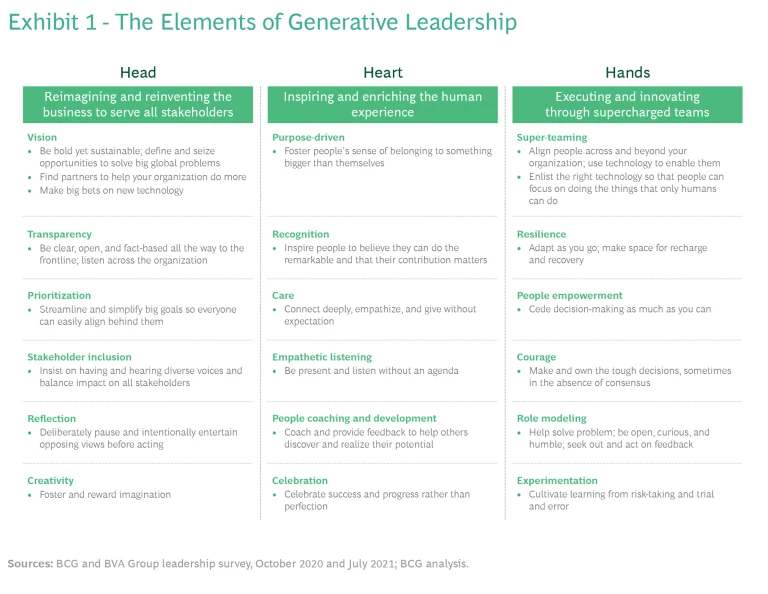
The Head: Reimagining and Reinventing the Business to Serve All Stakeholders
Generative leaders have bold visions for the future. They seek to reimagine and reinvent their business for the benefit of all stakeholders. For a generative leadership team, ESG is not a token gesture subordinate to the core business. Sustainable practices are essential to how the business makes money.
Generative leaders not only reimagine their own company's products and services. They lead the way across organizations to reinvent their industries. They cultivate and reward creative thinking in their teams. They pursue new technologies and realize ideas that once seemed impossible.
Consider the efforts of Pfizer and other organizations to produce a billion doses of a COVID-19 vaccine in record time. To achieve this breakthrough, Pfizer deployed cutting-edge technology and rigorously prioritized work. Pfizer also engaged in radical transparency, so that all employees understood the vision and what they needed to do to achieve it. In a generative organization, transparency works in both directions, ensuring that the leadership team understands and responds to the perspectives of people on the frontline. The best generative leaders achieve the same transparency, alignment, and feedback with respect to stakeholders outside the organization, too.
Enel, an Italian energy utility, is a powerful example of what can happen when leaders take a generative approach. Francesco Starace became CEO of Enel in 2014. When he and his leadership team decided to move their staid industry into renewable energy, they made some remarkably bold and transformational bets over the course of six years:
- They invested in 1,000 startups after reviewing more than 16,000 ideas and pitches.
- They encouraged team members to spend 20% of their time on innovative projects in order to build a culture of innovation and sustainability.
- They introduced a “my best failure” initiative to promote creativity and encourage team members to take risks.
- They rolled out a crowdsourcing platform that allowed outsiders to propose solutions to different innovation challenges; the platform now includes 500,000 participants from more than 100 countries.
To implement these initiatives, Enel reinvented its approach to leadership. It advocates and celebrates team leadership, not heroic individual leaders. In 2021, Guido Stratta, Enel’s head of people and organization, published an essay on “soft leadership,” writing, “We will move from ‘me’ to ‘we.’” This leadership model, he continued, “is attentive to relationships, trust, and respect for each person’s talents, while continuing to focus on achieving objectives.”
Six years after it began this program of reinvention, Enel became the world’s largest supplier of renewable energy. Its bold and creative vision paid off handsomely for shareholders: in those six years, Enel increased its market value by 2.6 times.
The Heart: Inspiring and Enriching the Human Experience
Generative leaders seek to inspire and enrich the human experience by building great cultures and workplaces where people can do their best work. Employees value recognition and a sense of belonging and a clear purpose that is bigger than themselves. In fact, in our survey, the top four qualities that employees said they seek in their leaders relate to the heart. (See Exhibit 2.)
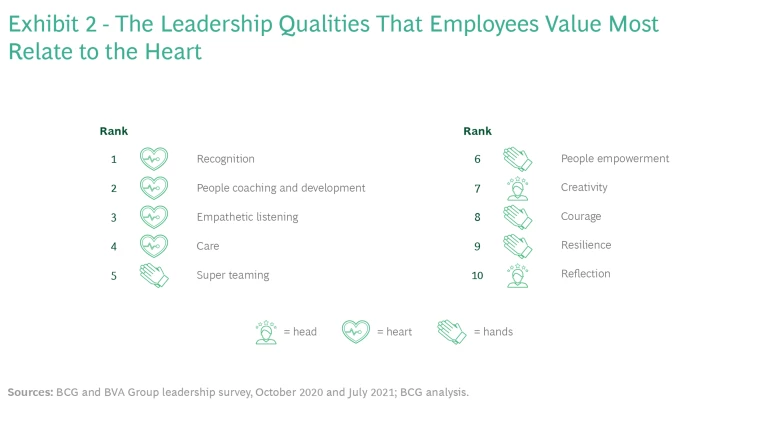
Generative leaders achieve these goals by investing in relationships with people. They’re empathetic and give of themselves without any expectations, especially during difficult times. Rather than standing apart, they engage with their teams. They prioritize coaching and development in order to help people realize their full potential. And they push upskilling and reskilling so people can meet the demands of always-on transformation. They also insist on celebrating success, learning, and progress—progress, not just perfection.
Above all, generative leaders genuinely care about people—and that extends beyond the workplace. As Francine Katsoudas, Cisco’s executive vice president and chief people, policy, and purpose officer, told us, “We care about our people even on the weekends.” Consistent with this 24/7 caring philosophy, she alerted her leadership team to managers’ need for more support early in the pandemic, leading Cisco to significantly expand access to mental-health resources.
Cisco cares about its people because it’s the right thing to do, Katsoudas told us. And what’s right also happens to be good for business. Cisco was named the best company to work for by Fortune in 2021.
Best Buy has likewise done an exceptionally good job on the heart dimension of leadership. Under former CEO Hubert Joly, the company undertook a successful turnaround that emphasized the employee experience, while its stock generated annual returns of around 20%. “Everybody was saying, ‘You better cut, cut, cut, close stores, fire a lot of people,’” Joly told Harvard Business Review in 2021. “The usual recipe of turnarounds. No, it started with listening to the frontliners. They had all of the answers. And I spent my first week in a store in St. Cloud [Minnesota] with my blue shirt and my khaki pants, the badge called ‘CEO in Training,’ to just listen to the frontliners.”
“Headcount reduction is the last resort,” Joly said. Rather than increasing value by extracting personnel costs, Joly and his leadership team pushed to find generative solutions. “Everybody wants to do something good to other people, and see how it connects to their work. Create an environment that’s very human. Where there’s genuine human connection. Where you can focus on creating the environment where they can become the best, biggest, most beautiful version of themselves.”
However, improving the human experience is where leaders are most likely to fall short. Our work with clients undergoing major transformations suggests that leaders devote the least amount of time and energy to those qualities. (See Exhibit 3.)
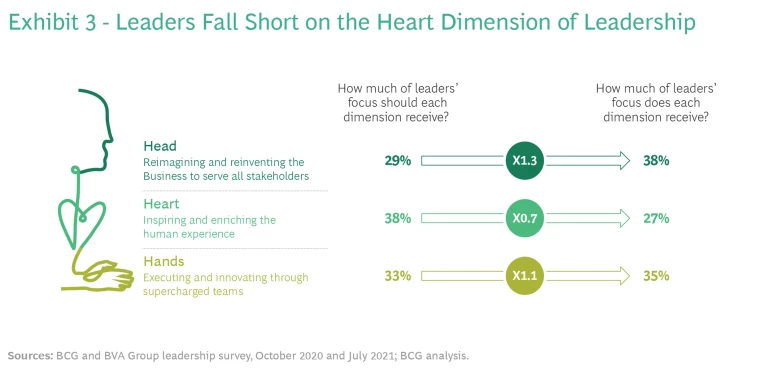
Interestingly, our survey also suggests that employees in advanced economies value the heart dimension more than those in other parts of the world. (See Exhibit 4.)
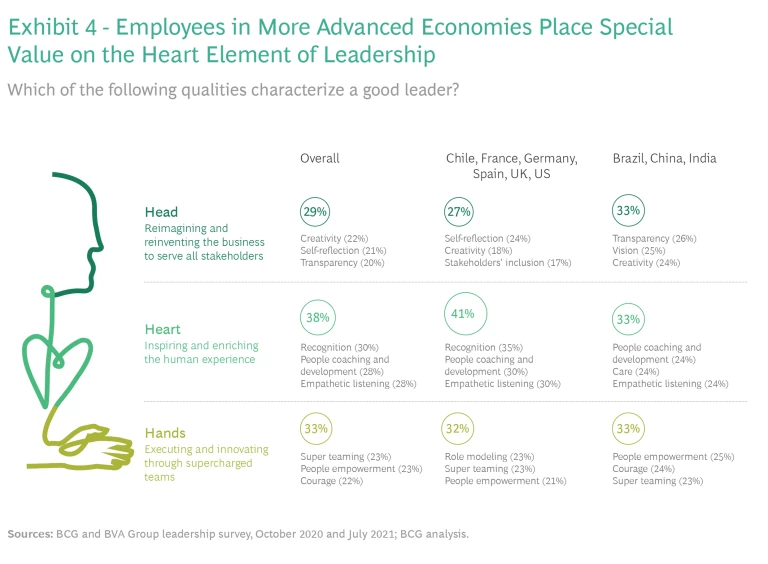
The Hands: Executing and Innovating Through Supercharged Teams
Generative leaders reimagine leadership as a team sport. It’s no longer possible, if it ever was, for the hero CEO to grapple alone with the complexity of our constantly and exponentially changing world. Instead, generative leadership calls on leaders to form teams of people with different perspectives within and across organizations, making sure that they don't neglect a key voice or stakeholder. They create high-functioning, empowered, cross-functional "supercharged" teams that execute and innovate with agility. These teams can move quickly and in unison, anticipating where the ball will land rather than focusing on where it is today. They adapt to changing conditions. Their members’ primary allegiance is to the team, not to whatever part of their organization they come from. Generative leaders build resilience in their teams by ensuring a balance between sprints and recovery.
Generative leaders build these teams and organizations in several ways. First, they engage directly with team members, showing up at team events and on video calls and other occasions. They even work on the frontline, as Joly did, to see things from the bottom up.
Second, generative leaders ensure that teams work together in the service of the overall purpose and strategy, so that the organization functions as a single entity. They see their role as removing roadblocks. They are willing to dirty their hands to help solve problems.
Third, they cede decision making to their teams without passing the buck. They have the courage to make and own tough decisions, sometimes in the absence of consensus. They incorporate AI and other new technologies into core workflows to speed up processes and free up people to do the things that machines can't do.
Generative leaders also seek to be role models: they are open, curious, vulnerable, and humble, and they seek out and act on feedback. They encourage learning through experimentation, and they reward risk taking and continuous improvement.
Finally, generative leaders embrace ecosystems of partners, especially those that augment AI and other digital capabilities. These ecosystems require leaders to exert influence over people outside of their direct control. For many leaders, this may mean developing a new muscle.
More broadly, generative leaders are engaged with the outside world. They demonstrate connection and influence with outside stakeholders. They are proficient in the world of social media.
Pfizer is a powerful example of executing and innovating at lightning speed as a united team. Early in 2020, Pfizer began a company-wide push to produce a vaccine against COVID-19. Critically, it formed a supercharged team with Germany’s BioNTech, a specialist in the development of mRNA vaccines, and a network of academic experts. Michael Dolsten, Pfizer’s chief scientific officer and president of its worldwide research, development, and medical organization, told us that employees were galvanized to solve this pressing global problem. “Everyone felt that an individual person could make a big contribution to the team effort,” he said. Dolsten credits CEO Albert Bourla with rallying the entire team to do what had never been done before. The sense of shared purpose broke down silos. Pfizer became “an unstoppable team,” he said. “We needed R&D, manufacturing, everybody to perform at the highest possible level."
Generative leaders believe that their obligation to society and the planet is at the core of their businesses, not just an afterthought.
To reach this goal, Pfizer created multidisciplinary teams among R&D, manufacturing, and other parts of the business. It also inverted the traditional project timeline, imposing a deadline of eight months instead of determining the timeline by working backward from each step in the process. Each step was allocated a time slot within those eight months. Serial processes became parallel whenever possible. These measures allowed Pfizer to have its vaccine available by winter in the northern hemisphere. It’s hard to overstate how ambitious the eight-month deadline was. Dolsten estimated that such a development process would normally take seven or eight years. But Pfizer's teams "didn’t want to let other teams down.”
As we now know, these multidisciplinary teams succeeded in partnership with their collaborators. By the end of 2021, Pfizer had delivered more than a billion vaccine doses globally.
Putting Generative Leadership into Practice
Of course, leadership teams can't wait for a pressing global pandemic to help them break down silos and form teams of champions. What are leaders to do? Are they all in a position to reinvent their businesses, enrich the human experience of their employees, and execute and innovate through supercharged teams? If they’re not close today, how do they get closer?
As we’ve said before, generative leadership is a team sport. It can't be pursued in isolation. The shift from a "me" sport to a "we" sport requires trust and team behavior across the organization, as well as continual feedback, reflection, and coaching. The path will be different for different leadership teams, because no two teams will have identical starting points or needs.
Becoming more generative is a long-term pursuit. Like healthy living or athletic conditioning, it requires fundamental and permanent lifestyle change rather than episodic training or dieting.
Whether you are already on the journey or just getting started, the following practices can help leaders and leadership teams become more generative. They will help clarify the mission of a leader and a team by focusing them on the head, the heart, and the hands of leadership.
Head. To help further develop these capabilities:
- Ask yourself and the members of your team what your organization would need to do to reduce its carbon footprint by half. How would the overall business operate? How long would it take? Could you do it in half the time?
- Set up a monthly sounding-board session with select customers, suppliers, employees, and societal stakeholders to solicit suggestions on how to further improve your organization’s environmental and social impact. How could you achieve that impact while increasing profitability? Which disruptive technologies, such as AI and deep tech, could you leverage? With whom would you need to partner?
Heart. To help further develop this muscle:
- Reserve a few minutes at the end of team meetings to reflect on the purpose of your organization:
- Recognize the achievements of your teams and how they contribute to your purpose.
- Solicit feedback on how helpful the meeting you just had was—and how to improve it next time.
- Try to make a habit of this. Do it weekly or monthly.
- Spend at least a few days each quarter with frontline employees in order to understand their daily work and listen to their concerns. It’s not enough to shake hands or appear on occasional video calls with the team. “Being present” means more than meeting and greeting team members. It means spending enough time with them to understand their ideas about how things might be improved and where they need your help.
- Create a plan to make your benefits and support for team members and their families best in class. Start by finding out what your team members truly need and value. Understand how those needs vary across different groups of employees. Then identify a set of actions you can take to improve support immediately.
- Block out an hour a week to check in one-on-one with team members—junior people, peers, or partners—about how they and their families are doing and how they feel about their work. Throw away the agenda and listen; these conversations build heart.
Hands. To help further develop supercharged teams and other capabilities:
- Ask yourself which of your priorities could be better achieved by increasing cross-functional teaming both inside and outside of your organization. Where do you need more people working across current team boundaries? How can you help them to do so?
- Invite a different set of team members monthly to provide feedback on how they can better leverage technology to supercharge their work. Do your team members have the right set and amount of data to make informed decisions? Are their tech tools helping or hindering their ability to create supercharged teams?
- Upskill yourself in one or two areas, such as AI, big data, or virtual collaboration tools. Then talk about what you are learning whenever you can.
Throughout the world, we are starting to see generative leadership teams emerge. These teams are pursuing a better vision for the workplace, for society, and for the planet. Their view of the future is bright and optimistic, and they are committing their companies to renewing the earth's depleted resources. In this moment of tremendous and accelerating change, the world is calling for leaders who can stand up and make a lasting difference. Generative leaders are answering the call.
Acknowledgments
The authors would like to thank the following colleagues for their valuable contributions to the development of this article: Cailin Ahern, Vikram Bhalla, Divya Chanana, Kristy Ellmer, Wanjun Fang, Grant Freeland, Brittany Heflin, Bill Higgins, Philippine Leccia, and Mickey McManus.



